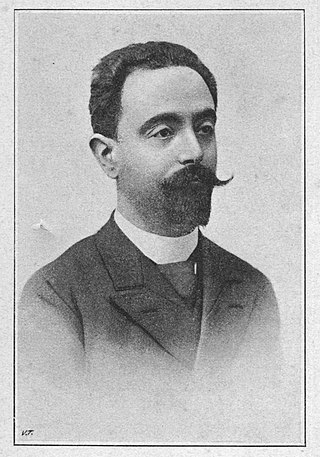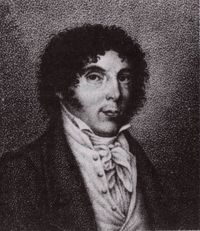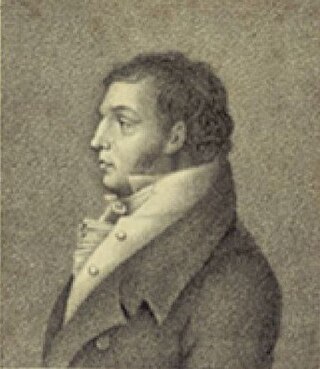Related Research Articles

NiccolòPaganini was an Italian violinist and composer. He was the most celebrated violin virtuoso of his time, and left his mark as one of the pillars of modern violin technique. His 24 Caprices for Solo Violin Op. 1 are among the best known of his compositions and have served as an inspiration for many prominent composers.

Monza is a city and comune on the River Lambro, a tributary of the Po in the Lombardy region of Italy, about 20 kilometres north-northeast of Milan. It is the capital of the Province of Monza and Brianza. Monza is best known for its Grand Prix motor racing circuit, the Autodromo Nazionale di Monza, which hosts the Formula One Italian Grand Prix with a massive Italian support tifosi for the Ferrari team.

The Iron Crown is a relic and may be one of the oldest royal insignia of Christendom. It was made in the Early Middle Ages, consisting of a circlet of gold and jewels fitted around a central silver band, which tradition held to be made of iron beaten out of a nail of the True Cross. In the medieval Kingdom of Italy, the crown came to be seen as a relic from the Kingdom of the Lombards and was used as regalia for the coronation of the Holy Roman Emperors as kings of Italy. It is kept in the Duomo of Monza.

Luigi Cherubini was an Italian Classical and Romantic composer. His most significant compositions are operas and sacred music. Beethoven regarded Cherubini as the greatest of his contemporaries. His operas were heavily praised and interpreted by Rossini.

The Duchy of Parmaand Piacenza, was an Italian state created in 1545 and located in northern Italy, in the current region of Emilia-Romagna.

Vittorio Monti was an Italian composer, violinist, mandolinist and conductor. His most famous work is his Csárdás, written around 1904 and played by almost every Romani orchestra.

The Kingdom of Italy, also called Imperial Italy, was one of the constituent kingdoms of the Holy Roman Empire, along with the kingdoms of Germany, Bohemia, and Burgundy. It originally comprised large parts of northern and central Italy. Its original capital was Pavia until the 11th century.

The Diocese of Tortona is a Latin Church ecclesiastical territory or diocese of the Catholic Church in Northern Italy, spanning parts of three regions of Piedmont, Lombardy and Liguria. It is a suffragan diocese in the ecclesiastical province of the metropolitan Archdiocese of Genoa and forms part of the ecclesiastical region of Liguria. The diocese claims to be one of the oldest in Lombardy and the Piedmont.

Carlo Munier (1858–1911) was an Italian musician who advocated for the mandolin's acknowledgement among as an instrument of classical music and focused on "raising and ennobling the mandolin and plectrum instruments". He wanted "great masters" to consider the instrument and raise it above the level of "dilettantes and street players" where it had been stuck for centuries. He expected that the mandolin and guitar would be taught in serious orchestral music schools and incorporated into the orchestra. A composer of more than 350 works for the mandolin, he led the mandolin orchestra Reale circolo mandolinisti Regina Margherita named for its patron Margherita of Savoy and gave the queen instruction on the mandolin. As a teacher, he wrote Scuola del mandolino: metodo completo per mandolino, published in 1895.

Leonhard von Call, sometimes referred to as "Leonhard de Call", was an Austrian composer and virtuoso on the mandolin and guitar. During his lifetime he focused less on performing and more upon teaching and writing music for others to play. A virtuoso, he wrote not for other virtuosos but for the people he was teaching or amateurs, and today it is felt by some musicians that his works "made no great technical demands".

Stefano Pavesi was an Italian composer. He is primarily known as a prolific opera composer; his breakthrough opera was Fingallo e Comala, and his acknowledged opera masterpiece is Ser Marcantonio. He also served as the maestro di cappella of Crema Cathedral from 1814 to 1818, and alone from 1818 until his death at the age of 71.
Angelo Mascheroni was a pianist composer, conductor, and music teacher, brother of the conductor Edoardo Mascheroni. He is most famous for his "Eternamente" for voice and violin, sung by Enrico Caruso; his two-act opera Il mal d'amore, with a libretto by Ferdinando Fontana, was written in 1898. Among his pupils was Spyridon Samaras.

Bartolomeo Bortolazzi was a performing musician, composer, author, and virtuoso of both the guitar and the mandolin. He was credited by music historian Philip J. Bone as helping to pull the mandolin out of decline.
C. A. Bracco was an Italian mandolinist, violinist and conductor, deserving notice by his compositions for mandolin band. While not a prolific composer, he was the author of several operettas and ballets which were produced in his native land. His published works were principally for mandolin and guitar or violin and piano, and were issued solely in Italy.

Giuseppe Branzoli was a violinist, mandolinist, composer, author, educator at the Liceo Musicale di St. Cecilia in Rome, and the founder of the periodical IL mandolin Romano. His compositions were for violin, mandolin, flute and cello, as well as church music.
Carmine de Laurentiis was a 19th-century Italian mandolinist, musical educator, author and composer who taught mandolin and guitar in Naples. His only well-known student was Carlo Munier. He wrote a mandolin method, Metodo per Mandolino, that was published in Milan in 1874, reported the following year in the Musical World. The article mentioning Laurentiis' method talked about the decline of the mandolin, calling the mandolin "entirely out of fashion."

Pasquale Vinaccia was an Italian luthier, appointed instrument-maker for the Queen of Italy, and maternal grandfather to Carlo Munier. In 1835 he improved the mandolin, creating a version of the instrument that used steel wires for strings, known today as the "Neapolitan Mandolin." His use of steel strings has become the dominant way of stringing mandolins.

Eliodoro Bianchi was an Italian operatic tenor and later a prominent singing teacher. Born in Cividate al Piano and trained in Naples under Giacomo Tritto, he made his stage debut in 1793. Amongst the many roles, he created during the course of his 40-year career were Baldassare in Ciro in Babilonia and the King of Sweden in Eduardo e Cristina, both of which were composed by Rossini expressly for Bianchi's voice. He retired from the stage in 1835 and spent his later years in Palazzolo sull'Oglio, where he died at the age of 75.